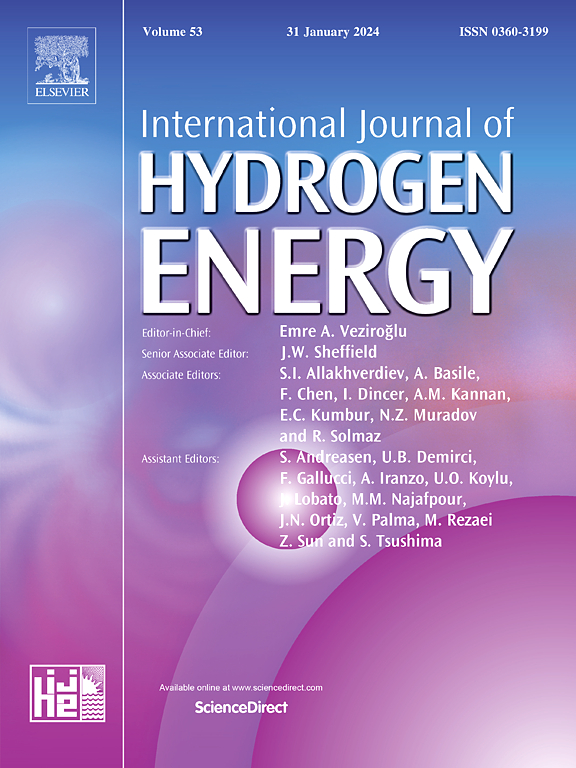低温热循环后gnp改性环氧树脂/碳纤维复合材料储氢性能评价
IF 8.3
2区 工程技术
Q1 CHEMISTRY, PHYSICAL
引用次数: 0
摘要
碳纤维增强聚合物(CFRP)复合材料因其高强度重量比和耐久性而广泛应用于储氢系统。然而,重复的低温热循环,如在氢燃料应用中所经历的,会引起热应力,导致微开裂、基质纤维脱粘和机械性能下降。本研究探讨了石墨烯纳米薄片(GNPs)对增强碳纤维复合材料低温耐久性的影响。将GNPs以不同的浓度(0-0.75 wt%)掺入环氧树脂基体中,复合材料在- 196°C至60°C之间进行受控热循环。短束强度测试评估了机械性能,而扫描电子显微镜(SEM)和拉曼成像检查了微结构损伤和弥散。结果表明,与未经改性的CFRP相比,掺入0.1 wt%和0.25 wt% GNPs的CFRP在循环前强度分别提高了约9%和10%,在25次循环后强度提高了20%。与未改性复合材料13.3%的强度损失相比,经gnp改性的复合材料由于循环造成的强度降低被限制在4.9%和5.7%。相比之下,0.75 wt%的GNPs会导致团聚,增加开裂,降低性能。扫描电镜证实,在最佳GNP浓度下,裂纹减少,界面附着力改善。这些发现表明,分散良好的GNPs显著增强了CFRPs在低温循环下的机械弹性,使其在储氢方面具有很大的应用前景。本文章由计算机程序翻译,如有差异,请以英文原文为准。
Performance evaluation of GNP-modified epoxy/carbon fiber composites after cryogenic thermal cycling for hydrogen storage applications
Carbon fibre-reinforced polymer (CFRP) composites are widely used in hydrogen storage systems due to their high strength-to-weight ratio and durability. However, repeated cryogenic thermal cycling, as experienced in hydrogen fuel applications, can induce thermal stresses that lead to microcracking, matrix-fibre debonding, and reduced mechanical performance. This study investigates the influence of graphene nanoplatelets (GNPs) on enhancing the cryogenic durability of CFRPs. GNPs were incorporated into the epoxy matrix at varying concentrations (0–0.75 wt%), and composites were subjected to controlled thermal cycling between −196 °C and 60 °C. Short-beam strength testing assessed mechanical performance, while scanning electron microscopy (SEM) and Raman mapping examined microstructural damage and dispersion. Results showed that, compared to unmodified CFRP, the incorporation of 0.1 wt% and 0.25 wt% GNPs increased strength by approximately 9 % and 10 %, respectively, before cycling, and by up to 20 % after 25 cycles. Strength reductions due to cycling were limited to 4.9 % and 5.7 % for the GNP-modified composites, compared to a 13.3 % loss observed in the unmodified composites. In contrast, 0.75 wt% GNPs led to agglomeration, increased cracking, and lower performance. SEM confirmed fewer cracks and improved interfacial adhesion at optimal GNP concentrations. These findings demonstrate that well-dispersed GNPs significantly enhance the mechanical resilience of CFRPs under cryogenic cycling, making them promising for hydrogen storage applications.
求助全文
通过发布文献求助,成功后即可免费获取论文全文。
去求助
来源期刊

International Journal of Hydrogen Energy
工程技术-环境科学
CiteScore
13.50
自引率
25.00%
发文量
3502
审稿时长
60 days
期刊介绍:
The objective of the International Journal of Hydrogen Energy is to facilitate the exchange of new ideas, technological advancements, and research findings in the field of Hydrogen Energy among scientists and engineers worldwide. This journal showcases original research, both analytical and experimental, covering various aspects of Hydrogen Energy. These include production, storage, transmission, utilization, enabling technologies, environmental impact, economic considerations, and global perspectives on hydrogen and its carriers such as NH3, CH4, alcohols, etc.
The utilization aspect encompasses various methods such as thermochemical (combustion), photochemical, electrochemical (fuel cells), and nuclear conversion of hydrogen, hydrogen isotopes, and hydrogen carriers into thermal, mechanical, and electrical energies. The applications of these energies can be found in transportation (including aerospace), industrial, commercial, and residential sectors.
 求助内容:
求助内容: 应助结果提醒方式:
应助结果提醒方式:


